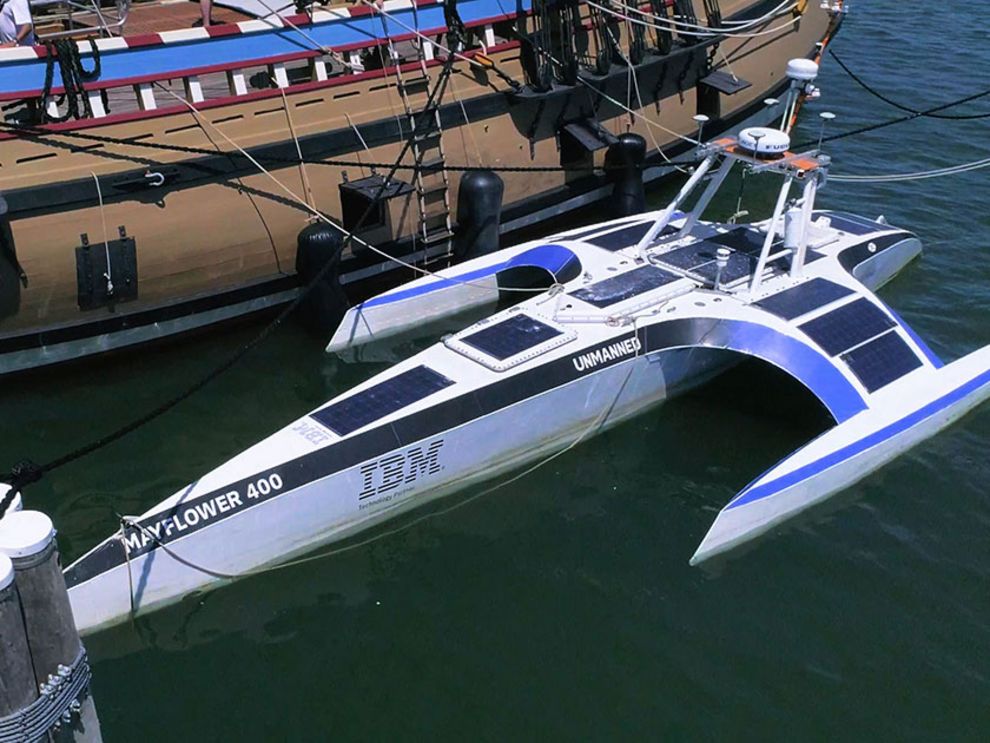Mayflower, Oceanus and Peregrine: AI on the Seven Seas.
The first AI-guided voyage across the North Atlantic from Plymouth, England, to Halifax, Canada, was just a start. Now the Mayflower Autonomous Ship (MAS) is undergoing a process of optimization in Massachusetts before being used for other scientific projects. In addition, the AI-controlled fleet is being expanded: one larger and six smaller autonomous ships will soon be built.
#Company #IBM #IBM Z #Artificial Intelligence
MAS, a 15-meter solar-powered trimaran packed with IBM cognitive computing technology, made the unmanned journey across the rugged North Atlantic in 40 days last June (including a stop in the Azores)[i]. The intelligent steering system processed information from six built-in cameras and 50 sensors. The new Mayflower is powered electrically; the energy comes from solar panels, which were in turn supported by a diesel generator[ii].
A hybrid ship with a range of over 5,000 miles
Much has been learned from the unmanned voyage across the Atlantic, according to project manager Brett Phaneuf. He is the owner of the companies that built the Mayflower and the executive director of the nonprofit marine research organization ProMare, which operates the ship and manages the project. The lessons learned are now being implemented: The Mayflower is docked at the Woods Hole Oceanographic Institute in Massachusetts and is being refitted[iii]. Various new systems are being installed. For example, new twin generators. Also, some new computer systems and new batteries which are more efficient and give the ship greater range and performance. "We took the opportunity to replace everything that needed improvement. Now we have a refined, highly efficient, highly redundant system that should deliver even better performance. We expect the range of the ship to be 5,000 miles or more now" explains Brett Phaneuf. The two generators are diesel units; here the Mayflower works like a hybrid car. That is, the solar panels charge the batteries, which then provide all the power for the engines and all the systems. When more power is needed, one or both generators kick in and charge the batteries.
A full research program for the renewed Mayflower
Over the next few weeks, MAS will be heading out to do its part in what is known as the Ocean Twilight project. Woods Hole operates a seafloor installation several hundred miles offshore, at the edge of the Gulf Stream, that uses a sophisticated array of sonars to look up and study the vertical migration of zooplankton and phytoplankton, as well as biomass. Research will be conducted on what happens in the warm eddies that run off the Gulf Stream, which contain a lot of life. MAS will cruise in the same ocean area but look downward, to the ocean floor. Because the Mayflower is mobile, it will be able to respond dynamically to changes and track the data of interest.
After a trip north, the Mayflower will return to conduct more survey work and research with Woods Hole and spend the winter there. The ship's schedule is also full for next year, with MAS sailing around Bermuda in the spring and eventually landing in Norfolk and Virginia, where the ship will be used to conduct a variety of acoustic work and basic ocean health surveys. IBM is the lead technology partner as well as scientific partner. Marine AI Ltd[iv] has developed the cognitive artificial intelligence that works on top of IBM's powerful operational decision manager (ODM) - software that many companies rely on for day-to-day decision making. Iridium supports the project with satellite communications[v].
More autonomous ships for science
Innovative technologies, combined with artificial intelligence, are being deployed on more and more ships. The point, says Brett Phaneuf, is to reduce the cost of collecting data and producing information about the oceans, and that is what sets the Mayflower apart. After the overhaul, she will be more efficient and quieter than ever and will be able to carry more scientific payload than before. "It's about having a safe way to go out to sea cost-effectively and bring back significant amounts of data that would otherwise be impossible or, at best, extremely costly to acquire," he explains.
That is why there will soon be a second autonomous ship for ocean research. Work is underway on a design for a 24-meter vessel called Oceanus, Phaneuf says. The ship is being developed with the Plymouth Marine Laboratory and other partners and is expected to be launched in 2025. It will have a range of about 12,000 nautical miles to operate continuously at sea. Oceanus will sail from Plymouth, United Kingdom, down to the southern oceans to the Falkland Islands and back again, collecting scientific data about the ocean and deploying sensors along the way.
The autonomous fleet is growing even further, with construction beginning as early as this fall on six 12-meter Peregrine-class ships specifically designed to collaborate and cooperate with each other and other vessels in ocean research. They are scheduled to be launched in late spring of next year. All of these vessels will be built in Plymouth, England, by MSubs Ltd.[vi].
Now we have a refined, highly efficient, highly redundant system that should deliver even better performance. We expect the range of the Mayflower to be 5,000 miles or more now.


AI in ocean shipping: Are humans still required?
What is the economic outlook for AI on the seven seas? According to Brett Phaneuf, the military is probably the biggest investor in this sector of technology. In the commercial market, there is no clear development. Large cargo ships, such as container ships, are already equipped with highly automated systems that perform data analysis outside the ship. They operate with exciting new machine learning-based technologies that specialize in weather routing and optimization to reduce fuel consumption. But the benefit of eliminating crew compared to the overall cost of the ship is not relevant, he says. "What we're more likely to see is the integration of sophisticated autonomous or AI-like systems into recreational boats to help inexperienced mariners be safer. A lot of technology is beginning to exist that helps maintain better situational awareness and is now being integrated into the bridge equipment of major marine electronics manufacturers.” Brett Phaneuf does not think there will be a radical change in this regard in the next 10 years: "We're on a slow march to a hybrid approach".
Leading edge technology
The autonomous ship Mayflower and its successors are groundbreaking technological accomplishments. They achieve their goals thanks to the support of a wide range of leading technology companies. The most important of these is IBM. UMB is the first and largest IBM Platinum Business Partner in Switzerland, specializing in infrastructure, software and solutions, namely security. UMB is the only IBM partner in Switzerland with Elite Specialty Status for IBM Power and Storage. Above-average know-how - in IBM hardware as well as in software and services - guarantees excellent cooperation. Contact us for additional information.
[i] The Mayflower Autonomous Ship Has Reached North America
[ii]Sun, Sea, and Artificial Intelligence: The Mayflower is on the Move (Again) (umb.ch)
[iii]Woods Hole Oceanographic Institution
How the autonomous ships got their names.
Two pregnant women traveled on the Mayflower in 1620, one of whom gave birth to a child halfway through the voyage to the New World. She named her son Oceanus. The second woman gave birth in Plymouth Harbor, and she named her son Peregrine . Peregrine White became known as the firstborn child of New England and later became a prominent farmer and military officer. Although it is difficult to give an accurate estimate, given the number of generations that have passed since Peregrine White's birth in 1620 and the possible branchings of his family line, it is safe to assume that there are thousands, if not tens of thousands, of descendants of Peregrine White living in the United States today. Oceanus tragically died at only two years of age.


